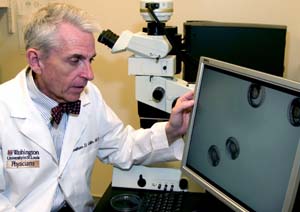The separate worlds of patient care and genomic science will be brought together in the new Division of Genetics and Genomic Medicine in the Department of Pediatrics at the School of Medicine.
Plans for the division map out a model of individualized medical care in which physicians look to a patients’ genetic makeup to determine the most effective treatment.

“We’ve unraveled the human genome, and in that genetic blueprint are answers to medical problems,” said Jonathan D. Gitlin, M.D., the Helene B. Roberson Professor of Pediatrics, professor of genetics and director of the new division. “Right now it isn’t possible to get all the answers we need and apply them to patients, but this division will establish a structure with which to begin that effort.”
The division will receive research grants and support from the School of Medicine and St. Louis Children’s Hospital.
“St. Louis Children’s Hospital has made a unique commitment by pledging financial support to the University for the new division at the School of Medicine as part of a new research collaboration to be announced later this year,” said Alan L. Schwartz, Ph.D., M.D., the Harriet B. Spoehrer Professor, head of the Department of Pediatrics and pediatrician in chief at Children’s Hospital.
“Hospital President Lee Fetter recognizes that an investment in the research programs stimulated by the Division of Genetics and Genomic Medicine will bring a strong return in the form of innovative care and new therapies.”
The new division’s goals mesh perfectly with BioMed 21, the University’s strategic research initiative that aims to translate basic genetic data into new therapies and includes faculty from the schools of Medicine, Engineering & Applied Science and Arts & Sciences.
Gitlin foresees the change to genetically based medicine as the inevitable next step in medical care. This shift is as ambitious as the U.S. decision to enter the space race in the 1960s, Gitlin asserted, and will produce a new approach to patient care that brings information from disparate fields together.
In effect, it will bring to the bedside of each patient dozens of research specialists — from genomic scientists to developmental biologists, as well as medical specialists from a wide variety of fields, such as oncology, cardiovascular disease and psychiatry.
As a result, patients will receive more effective care. Instead of hit-or-miss treatments that work for some patients but not others, genomic medicine will one day offer precise treatments that work with the unique physiology of individual patients.
“For example, the most important advance in asthma care in the next decade will come out of understanding the genetics of asthma,” Gitlin said. “Why are certain children susceptible to asthma? Why do certain children respond to asthma medications and others don’t? At the core, those answers come from each child’s genetics.”
To understand the genetic basis for diseases requires researchers to compare genes from thousands of people. The sheer amount of information is massive, and translating that data to medical treatments will necessitate cooperation and collaboration.
“We’re starting this at Washington University because of the breadth of talent here,” Schwartz said, “including of course, the Genome Sequencing Center and the Center for Genome Sciences, and the strong support of the medical school leadership, especially Dean Larry Shapiro, who believes it is important for us to take medicine in this direction.”
Because many of the antecedents to adult diseases such as type 2 diabetes and cardiovascular disease begin early in childhood, Gitlin and Schwartz say they believe the Department of Pediatrics — which ranks fourth nationally in research funding by the National Institutes of Health — provides an ideal foundation from which to launch the new division and to emphasize prevention as a cornerstone of medicine.
Understanding the interaction of genetics and environment that leads to disease gives pediatricians the opportunity to prevent the onset of diseases in children for which there is currently little hope for treatment.
The new division is gearing up to double its number of faculty by hiring six members who will occupy offices and labs in the McDonnell Pediatric Research Building.
Some faculty members will have interdisciplinary appointments, in genetics and genome sciences, for example, as well as in pediatrics. Gitlin believes the goals of the division will quickly attract seasoned collaborators as well as young physicians and researchers who want to be part of this new direction for medicine and who will be attracted to Children’s Hospital’s close affiliation with the School of Medicine.
“With this new division, we want to be able to bring everyone together — it’s a division without walls — and see if we can develop very far-reaching programs,” Gitlin said.